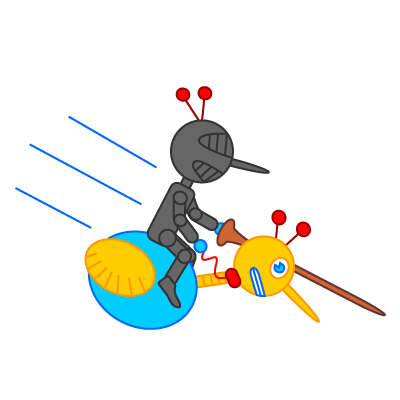 In any game, the more systems you implement, the more difficult it becomes to maintain a consistent game experience. Games tend to be at their best when they implement one system really, really well, although there are some notable exceptions.
In any game, the more systems you implement, the more difficult it becomes to maintain a consistent game experience. Games tend to be at their best when they implement one system really, really well, although there are some notable exceptions.
The easiest way to describe what we mean is with an example, and one of our favorite examples is Joust (mostly because it’s one of our favorite games).
We’d recommend giving it a go to better understand the example, but for the benefit of people who’ve never played it and don’t have access, here’s the gist: you’re a knight riding on a flying ostrich who must unseat all of the other knights flying around on their ostriches. That might sound a fever dream, but a few seconds in the game is enough to make it all come together.
Although we’re going with the Joust example, almost any classic Atari 2600 or arcade game fits the bill, because game designers back then faced two very stiff limitations that actually helped result in more consistent experiences: a controller with only one button and limited memory.
In Joust’s case, that button caused the bird the knight was riding to flap. Moving and flapping – that’s the entire game. But what a game.
Everything in it is designed to challenge players’ ability to move well and to flap well. You could only unseat other knights if you ran into them (“moved” into them) while your lance was higher than theirs. And to get it higher, you had to flap.
If that’s all it was, it wouldn’t be much of a game, of course, but it works because everything tested players’ abilities to move or flap.
The red knights eased their way higher than the player, always trying to hover just above, forcing the player to start their ascent early enough (while not too early) to avoid giving the red knights time to rise above them.
Gray knights were more aggressive, stirring their birds into action and flapping hard to stay above the player whenever the player gained the advantage.
And blue knights flew their birds like machines, making them flap faster than most players could hope to mash the button.
When the knights were unseated, they became eggs, which, if not collected fast enough, evolved into an even harder-to-kill enemy – testing players’ ability to move through enemies.
Just mashing the flap button carried a disadvantage, because there was a limit to how high you could go, and, worse, the ceiling, as well as all of the other platforms in the level, bounced you back down if you plowed into them.
Things aren’t all bad, of course, because the enemies are bound by the same rules (consistency again), so that limit is what allows a smart player to time their furious ascent to unseat even the most zealous of blue knights.
Joust also had other game elements that tested moving and flapping skills. One was the pterodactyl, which showed up if the player wasted too much time, and which required a precise lance in the face, making them much more difficult to kill (but also more rewarding in terms of score, for a great risk-reward system).
It also had lava, which prevented landings, and hands that would reach up out of the lava to grab low-flying birds. The hands weren’t an instant kill, however, because the knight could get away if their bird flapped hard enough. Again, the same system applied to both the player and the enemies (consistency).
Every system was designed to challenge moving well and flapping well, down to the fact that if you caught an egg from an unseated knight mid-air, it added to your score.
With modern game systems, we have plenty of buttons to choose from when we assign actions, and, in general, all the memory we could want. That’s a good thing, but it has also removed that constraint that once forced clever game developers into making consistent games.
Simple and consistent is not the only way to go, but it does help when creating a game that can appeal to a wider audience. People who grew up as gamers have gotten used to complicated systems, tens of buttons, and doing weird things for unclear goals, but people who haven’t touched a video game system since the Nintendo-era tend to find the experiences most gamers enjoy confusing.
Yet, sit someone in front of a game like Pacman, and they’re off and running in under a minute. With Pacman, you don’t even have a button to worry about and everything challenges the player’s ability to pick a path, from the pellets Pacman has to chomp, to the AI variety of the ghosts that chase him around the maze.
Although developers have more options than ever before, sometimes it’s worth taking a look at any system that goes into a game and deciding whether it enhances or distracts from the main play mechanic because a little restraint can go a long way.